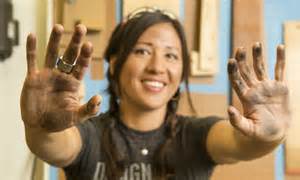Using Design and Creativity to Empower Students and Serve Community


Emily Pilloton is a designer, teacher, motivator, community builder, and a true force of nature. Pilloton studied architecture and product design at UC Berkeley and the School of the Art Institute of Chicago, and soon became frustrated by what she describes as the “consumption-for-consumption’s-sake mentality” in commercial design. In 2008, Pilloton co-founded Project H, an education and social advocacy nonprofit, the mission of which is to use “the power of creativity, design, and hands-on building to amplify the raw brilliance of youth, transform communities, and improve K-12 public education from within.” In Project H, “H” stands for “Humanity, Happiness, Health, Habitats.”
Project H’s first major undertaking—aided by grants from the W.K. Kellogg and Adobe foundations—was Studio H, an experimental course that combined classroom study of basic design with instruction in using building equipment and eventually actual participation in construction. To launch Studio H, Pilloton and co-founder Matthew Miller moved from San Francisco to the rural and economically depressed small town of Windsor, N.C. in 2010. Coordinating their class with the local school district and working out of a converted auto body shop, Pilloton and Miller taught a group of ten 11th-graders for three hours a day. The students ultimately designed and constructed their own 2,000-square-foot farmers’ market on land donated by the city. The market, completed in 2011, created four new businesses and 15 new jobs and was featured in “Architectural Record.”
“Design is nothing more than creative problem solving and a lot of chutzpah,” Pilloton said. “It is creating smart solutions to necessary problems, and doing so with a sense of critical optimism: the idea that the world can always be better and that we can have a hand in making it so. For kids, this is incredibly empowering. It gives them the space and permission to voice their craziest ideas and push them out in to the world. It also gives them the confidence that their voice matters, and that there are always tools at their disposal to grow and implement their ideas publicly and with impact.”
Pilloton moved back to the West Coast, where Studio H is now a permanent part of the curriculum at Realm Charter School in Berkley, Cal. More than 200 students, grades 8-11, take the course each year.
Project H, which is now supported by the National Endowment for the Arts and other prominent partners, also operates Camp H, an after-school and summer program that enables girls ages 9-12 to learn design skills, operate jigsaws and even welding equipment, and create projects of social relevance.
“I’m proud of my 10-year old camper girls who walk into our space with many doubts, then pick up a welder and leave thinking ‘What CAN’T I do?’” Pilloton said.
For adults, Project H offers Workshop H, a program in which teachers, education and community leaders, and young designers can learn professional development and new creative skills based on the Project H core ideas.
Over the past five years, more than 450 youth have participated in Project H design and building programs ranging from roadside farm stands to concrete sculptured furniture and laser-etched skateboards.
For her innovations in education and community building, Pilloton was featured as a TEDGlobal presenter, appeared on “The Colbert Report,” and has won prominent national honors. For its work in on the Windsor farmers’ market, Project H was written up in “The New York Times.”
Pilloton’s main focus is always on the future.
“I feel like I have a lot more work to do,” says Pilloton. “Maybe this is the blessing and curse of the design mentality: I celebrate our victories, but I know that we can always be better, and that we can always serve kids better.”
